On this page:
How did www.TexasBeyondHistory.net (TBH) begin and develop over the last few decades?
The idea for TBH grew from conversations in the late 1990s among forward-thinking Texas archeologists who sought to share what they were learning with the wider world. They included members of the Texas Archeological Society (TAS) and the short-lived nonprofit Texas Alliance for Public Archaeology (TAPA), including founding Editor Steve Black of the Texas Archeological Research Laboratory (TARL).
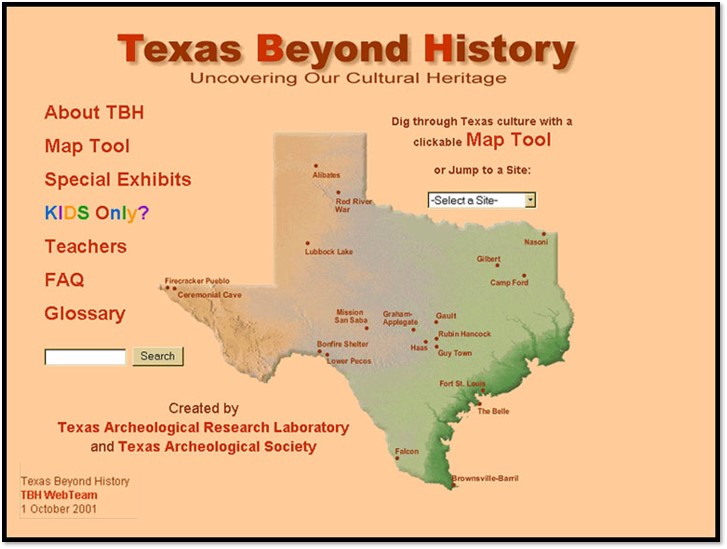
TAS President Tom Middlebrook appointed Black to chair a TAS committee charged with exploring the possibility of creating a glossy popular magazine on Texas archeology. The committee learned that print magazines faced long odds of success and required significant startup and operating costs. In fact, most new magazines folded within the first few years. What about the World Wide Web? At the time the perception was that relatively few TAS members were comfortable with the Internet.
Black discussed the challenge with fellow TAPA members including founder Richard Schott, Alston Thoms, Daniel Fox, and several others who understood the promise of the web. They explored the idea in several brainstorming sessions. There seemed to be as many good ideas as substantive obstacles. Fox remembers a Eureka moment when the website idea was embraced. The web yes, but some sort of online magazine or maybe more of an encyclopedia? Which organization would take on such a project? Where would the financial support come from? Who would contribute the content? Who would lead the project?
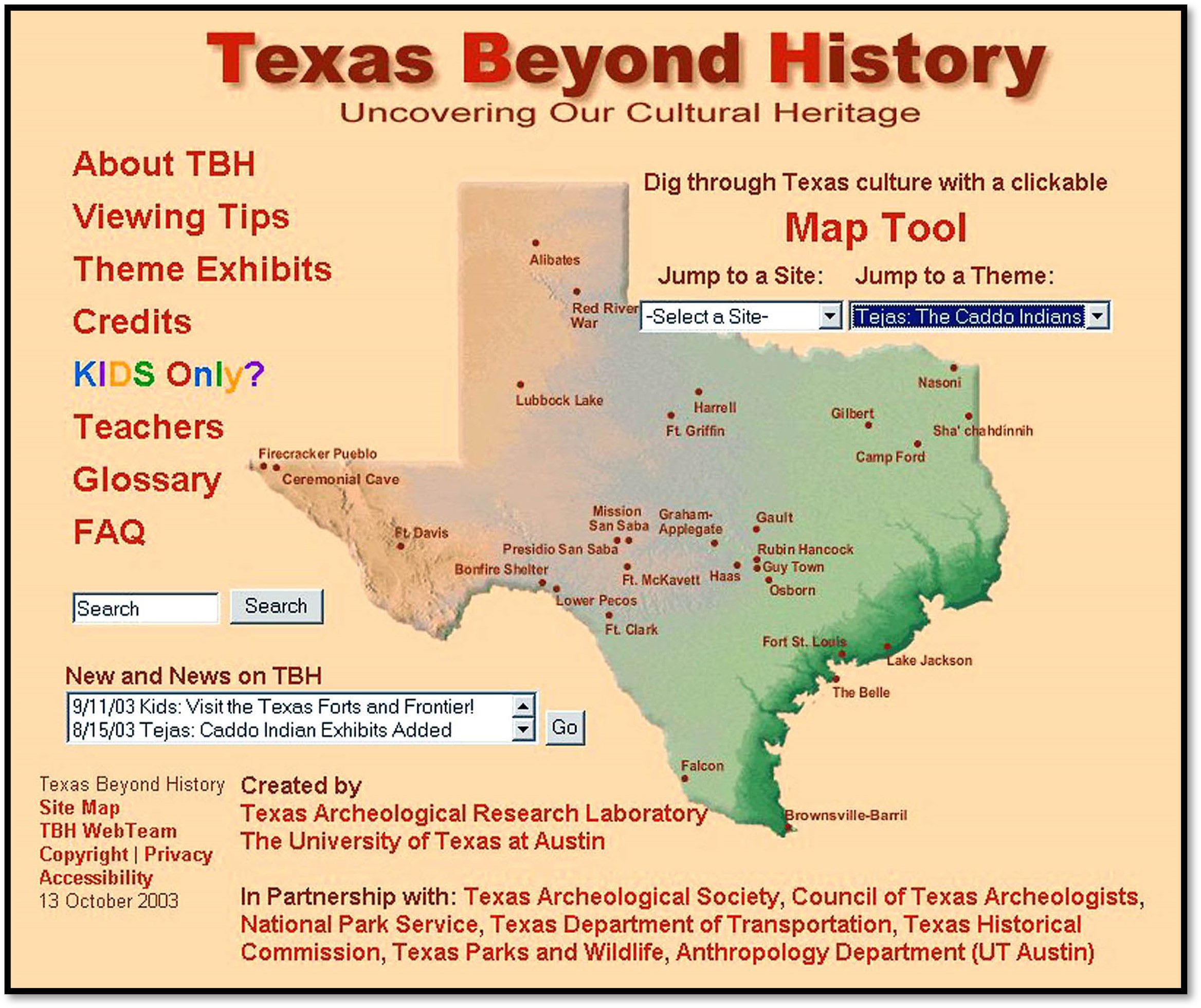
In late 2000 a plan began to gel. TARL Director Darrell Creel agreed to let Black give the web publication project a shot. Fellow TARL staff member Susan Dial became a critical player. Dial knew how to tell a story to the public by virtue of early career experience as a journalist. She also knew a lot more about history and historical archeology than Black did. And so the founding TBH editorial team formed.
Black and Dial debated what they aspired to create. They envisioned a publication like a magazine but encyclopedic in span—Texas’ cultural heritage writ large. Archeology led the way, as TARL is an archeological research laboratory and curation facility full of fascinating artifacts of the kind that could tell interpretive stories, but very few people ever got to see them. While TARL is not a museum, perhaps the website could serve as TARL’s online museum?
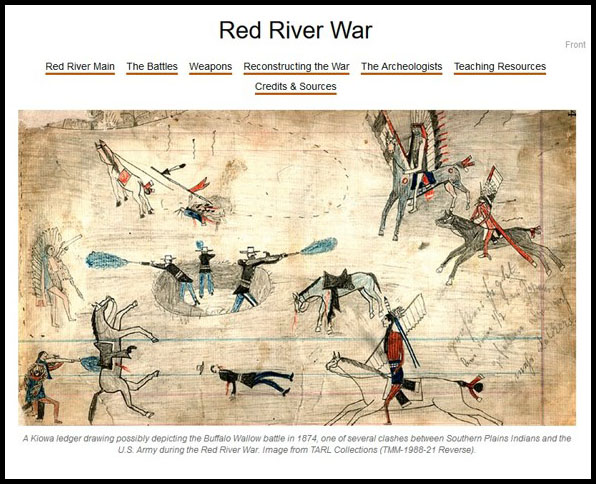
So they set out to create a hybrid—a website that presented research-based, journalistic online stories similar to long-read magazines such as the Smithsonian Magazine but lavishly illustrated like the National Geographic Magazine. Black and Dial chose to call themselves editors and realized they would need to convince many colleagues to contribute content. Most of the initial stories, they anticipated, would feature images of artifacts housed at TARL, which sounded more like a museum. Presenting compelling stories online would be a visual challenge—they would need to tell the stories with both words and images. Something along the lines of an illustrated lecture, like those being created by college professors using software such as PowerPoint. Journalistic research-based stories told by experts and illustrated by photographers and artists, presented as "exhibits" in a "virtual museum."
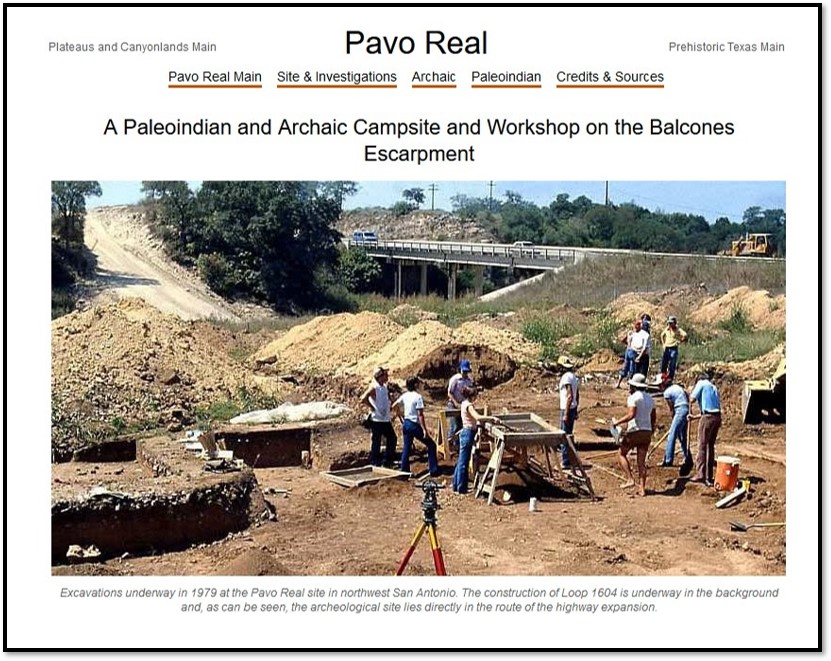
The title “Texas Beyond History” was chosen for the website to emphasize the goal of going beyond written history. The website would focus on the state’s long, mostly unwritten history and prehistory that archeologists and other researchers were bringing to light. They registered the website URL and chose the domain suffix .net to emphasize that the project would bring together a network of contributors, partner organizations, and sponsors.
Neither Black nor Dial knew much about web programming, which was still in its first decade—HTML 4.01 had just been released. They recognized that they needed someone on the TBH team who could design and code the website. UT student Meg Kemp fit the bill as the first TBH Web Developer. Kemp knew basic web programming, she had a background in anthropology, and she had a good sense of visual design.
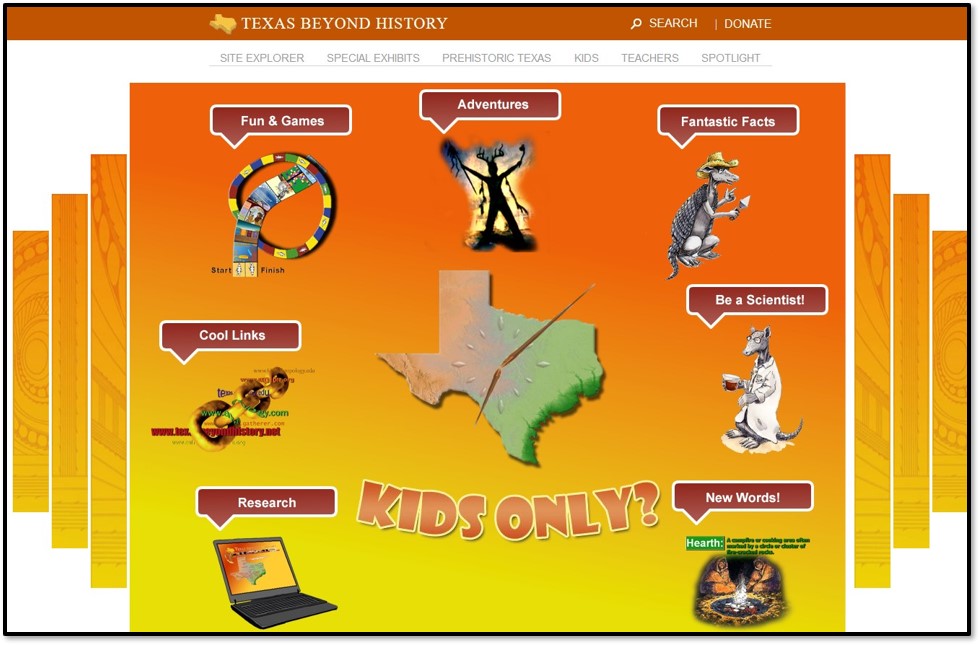
Black, Dial, and Kemp formed the initial TBH staff. The three came up with the basic design and site structure built around a map of Texas upon which site names appeared. Clicking on a named locality on the map would bring up what they termed a “site exhibit.” Over a frenetic 9-month period Black, Dial, and Kemp with twisted-arm help from archeological colleagues across the state and beyond created the first 20 site exhibits, some of them short single-page/section stories, others much longer multi-section presentations.
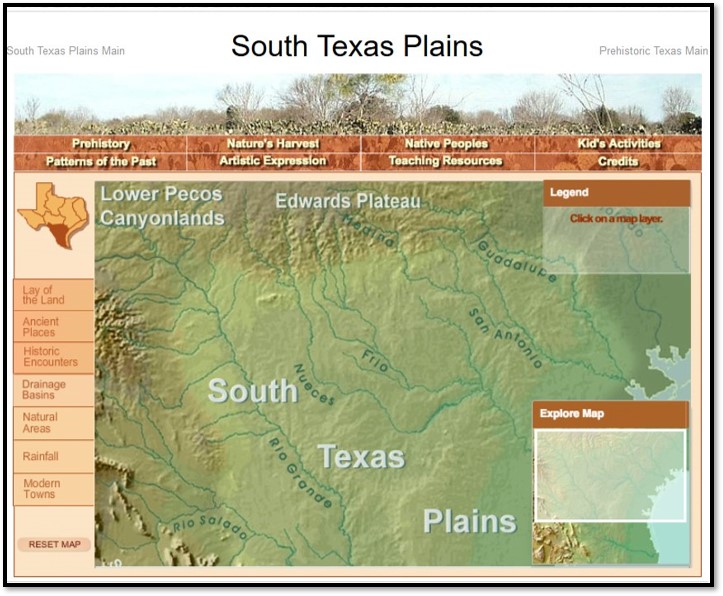
The Texas Archeological Society signed on as TARL’s founding partner and agreed to help underwrite the website startup. TARL was also awarded a modest grant from the College of Liberal Arts at UT Austin and Creel devoted additional TARL funds to the project. Other small grants came from the Lende Foundation and the Potts and Sibley Foundation. TAPA kicked in several thousand dollars. The final inaugural underwriter was the Amistad National Recreational Area (ANRA). ANRA archeologist Joe Labadie routed National Park Service funds to TARL to create interpretive exhibits on Bonfire Shelter and the Lower Pecos Canyonlands. As the Partners & Underwriters section attests, the cobbled-together funding approach has characterized TBH’s hard-won path since inception.

The TBH team knew from the get-go that they wanted to appeal to multiple audiences, some of whom would be most interested in the site exhibits and content aimed at archeologists and the general public. But a website aimed at public education needed to target two additional critical audiences—schoolchildren and their teachers. Serendipitously, Steve’s wife Dr. Mary S. Black was then a professor of education at UT-Austin who earlier had taught 7th grade history. And so she signed on as the first TBH Education Editor. Many of the first lesson plans on TBH were developed by graduate students in Mary Black’s UT summer class “Archaeology for the Social Studies.”
Throughout the two-decade history of TBH, hundreds of individuals from across Texas and in neighboring states have contributed content—expert text, photographs, illustrations, lesson plans, and much more. Most contributed content has been donated by TBH collaborators, individuals united in their goal of sharing what archeologists and historians have learned about the cultural heritage of greater Texas. Legions of contributors are listed in the Content Contributors section, although many other individuals who have helped in ways large and small and are acknowledged in the Credits and Sources sections included in all exhibits.

Ever since TBH first went live in October 2001, the Virtual Museum of Texas’ Cultural Heritage has continued to grow, exhibit by exhibit, kids’ activity by activity, year by year, decade by decade. The progress has been incremental and occurred in spurts and fits as funding and staffing have allowed. The website’s developmental history is reflected by the publication dates displayed at the bottom of exhibit pages. The first 20 site exhibits and the first special exhibit are all dated October 1, 2001. Since then over 50 exhibits have been added as well as many interactive activities aimed at schoolchildren and dozens of lesson plans for teachers. The best chronology is that presented in the New on TBH section where each major addition is listed by publication date.
In the website’s first few years (2001-2002) the TBH team added site exhibits on important excavated sites with collections and records held at TARL, especially sites where TAS field schools had been held. Soon the TBH editors began to develop exhibits based not on a single site, but on wider cultural patterns that demanded more comprehensive treatments. They called these "special exhibits" and in 2003 the first two sets of interwoven special exhibits, Tejas: Life and Times of the Caddo and Texas Frontier Forts debuted, followed by Plains Villagers of the Texas Panhandle in 2004. These special exhibt sets included integrated interactive activities for kids and lesson plans aimed at 4th and 7th grades when Texas history was taught.
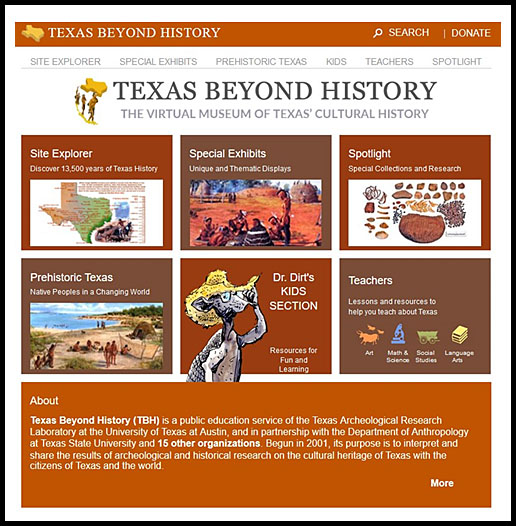
A major TBH milestone was the 2005 launch of Prehistoric Texas, a regionally-based website section that built on the approach used in the Tejas and Plains Villagers special exhibits. Plateaus and Canyonlands was the first Prehistoric Texas region to be created. This comprehensive "exhibit set," meaning an interwoven set of site exhibits, interactive maps, kid’s activities, lesson plans, and topical web pages all linked to a common theme, was one of eight physiographic regions of Texas. This content-rich, labor-intensive encompassing approach was possible due to a major grant from the National Endowment for the Humanities as well as smaller grants from foundations and agencies with vested interests in the regions. Three additional regions appeared over the next several years including South Texas Plains (2006), Trans-Pecos Mountains and Basins (2008), and the Coastal Prairies and Marshlands (2009). Four regions done, four still to come.

Raising the funds necessary to sustain and grow TBH was (and is) a major challenge. During the early years, Black and Dial paid themselves half-time wages (just enough to earn benefits) for months on end and continued working very long hours on TBH. Truth be told, the TBH editors are the prime or secondary authors of most TBH content. Student interns from UT-Austin and area colleges helped with photo scanning, research and some writing. In 2006, former TBH intern Heather Smith took over from Meg Kemp as TBH Web Developer.
In 2008 Black stepped down as the lead Editor of TBH and became a salaried professor of anthropology at Texas State University. Dial took over as lead Editor of TBH for the next decade. She encouraged cultural resource management (CRM) firms to sign on as sponsors of TBH site exhibits as part of public education outreach efforts connected to CRM mitigation projects. Examples include Varga (2009), Landis (2010), Lake Naconiche (2011), Pine Tree Mound (2013) and perhaps the most comprehensive single site exhibit yet to appear on TBH, the Ransom and Sarah Williams Farmstead (2014). Dial also created Spotlight pages which are comparatively short Special Exhibits which focus on the research and collections of the Texas Archeological Research Laboratory. Dial served as lead TBH Editor and director of the virtual museum from 2008-2019 when she semi-retired and Black resumed the helm.

In 2018 an extensive website revamp was completed, giving TBH a new look and improved functionality on mobile devices. The substantive web development work that made this possible was done by UT’s College of Liberal Arts Instructional Technology Services (LAITS). With ongoing programming help from LAITS, the website debuted its latest section the TBH Gallery in 2020. Other recent developments include the sponsored exhibit Hendrick and Ware Plantations (2021) and the first “how-to” special exhibit Radiocarbon Dating Understood (2022).
Recently (late fall 2022) TBH was awarded a new grant from the Texas Preservation Trust Fund (TPTF) by the Texas Historical Commission for a K-12 Revamp project. This initiative, which will involve updating and overhauling the Kids' and Teachers' sections, will unfold over 2023-2024. The TPTF grant required a 1:1 match of $20,000, which has been raised through donations from a growing number of Sustaining Partners, organizations that stepped up to help support TBH through annual donations. Several sponsored exhibits are in the planning stages, as well as a new regional exhibit. In other words, the story of Texas Beyond History continues to unfold!
TBH in the Press
The following press and awards are presented in chronological order with the most recent accolades at the top. Clicking the orange links will download or link to a publication of interest.
-
The Social Studies Texan
"Texas Beyond History K-12 Revamp" by Emily McCuistion.
Summer 2024 -
The Social Studies Texan
"Immigration to Texas in the 18th Century: The Journey of Maria Jesusita Curbelo-Delgado Smith's Canary Island Ancestors" by Emily McCuistion.
Winter 2023 -
The Social Studies Texan
"Texas Beyond History" by Emily McCuistion.
Summer 2023 -
The Social Studies Texan
"Finding Cultural Universals with the Ancient Egyptians and Texas Caddo Indians" by Carol Schlenk.
Fall/Winter 2015 -
The Social Studies Texan
"Ransom Williams: African American Legacy in Texas" by Carol Schlenk.
Fall/Winter 2014 -
TBH Education Advisor Wins Humanities Texas Award
Laine Leibick recognized as Outstanding Teacher of Humanities.
April 2014 -
Texas Archeology (Texas Archeological Society)
"New on Texas Beyond History: Pine Tree Mound."
Spring 2013 -
Texas Insights (Texas State Historical Association)
"Using Archeology as a Lens for Discovery: Students (and Teachers) Dig this Virtual Texas History Museum!"
August 2012 -
TBH Education Advisor Laine Leibick Recognized for Excellence in Teaching with HEB Lifetime Achievement Award
"Austin Teacher Wins HEB Lifetime Achievement Award" by Farzad Mashhood, Austin American Statesman.
May 6, 2012 -
Texas Historical Commission Award of Merit
Presented to Texas Beyond History Staff for "Excellent Public Outreach."
December 2009 -
Texas Highways Magazine
"Digging the Web" by Nola McKey.
May 2008 -
Austin American-Statesman
"An online version of the state's cultural legacy" by Ralph Haurwitz.
April 16, 2008 -
Texas Parks & Wildlife Magazine
"Hueco on the Web: New online exhibit gives readers window to the past" by Melissa Gaskill.
April 2008 -
Society for American Archaeology Award
Presented to Texas Beyond History for Excellence in Public Education, Vancouver, Canada.
March 2008 -
The Medallion
"A PostModern Historical Museum: New Exhibits Are Just a Click Away at Texas Beyond History Web Site" by Bill Martin.
January/February 2008 -
Texas Heritage Magazine
"Digging into Texas' Archeological History: No Shovel Required" by Pam Murtha.
Winter 2007 -
Life & Letters
"Dig Up Texas History Online" by Jennifer McAndrew.
Winter 2007-2008 -
College of Liberal Arts/College Events
"Texas Beyond History Launches New Cabeza de Vaca Exhibit."
August 2007 -
San Antonio Express-News
"Prehistoric South Texas Comes Alive on Web: Popular Site's New Exhibit Looks Back 13,500 Years" by Melissa Ludwig.
December 18, 2006 -
CRM: The Journal of Heritage Stewardship
"Texas Beyond History: The Virtual Museum of Texas Cultural Heritage" by Kenneth C. Craft, U.S. Department of Agriculture.
Winter 2006 -
The Social Studies Texan
"First in Texas: Clovis Builders at Kincaid Shelter" by Carol Schlenk and Susan Dial.
Summer 2006 -
The Medallion
"History at Your Fingertips: Educational Website Features New Exhibit on Prehistoric Texas" by Bill Martin.
July/August 2006 -
College of Liberal Arts: College News
Archeological Lab Receives NEH Grant: TARL to Develop Four New Web Exhibits for Texas Beyond History.
Spring 2004 -
Lubbock Avalanche-Journal
"Discovering History: Technology Enables Public to View Pieces of the Past" by John Davis.
August 27, 2002 -
UT Homepage Feature
"13,000 Years at Your Fingertips."
August 5, 2002 -
The Social Studies Texan
"Texas History Goes High Tech" by Dean Brumley, TEA.
Summer 2002 -
Texas Heritage Magazine
"Texas Beyond History: Bringing Texas Archeology to the World" by Steve Black.
Fall 2001 -
Dallas Morning News
"A Point-and-Click Texas History Trail" by Michael Granbury.
December 12, 2001